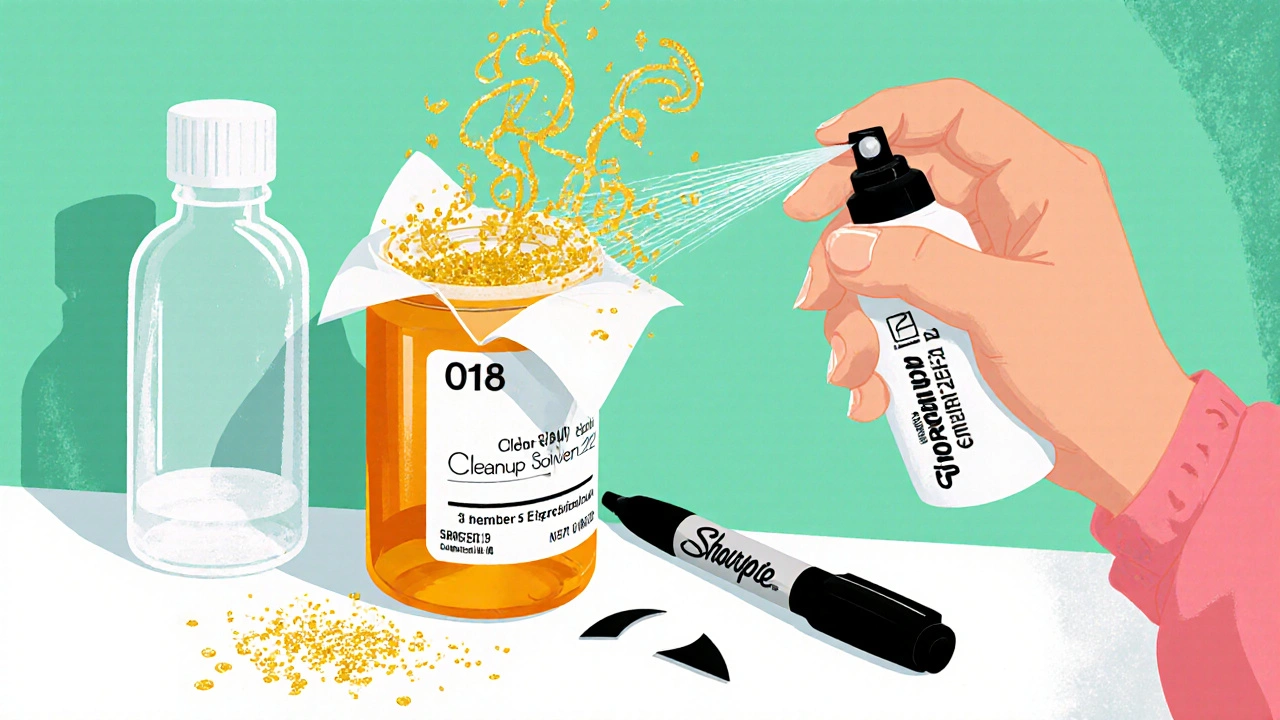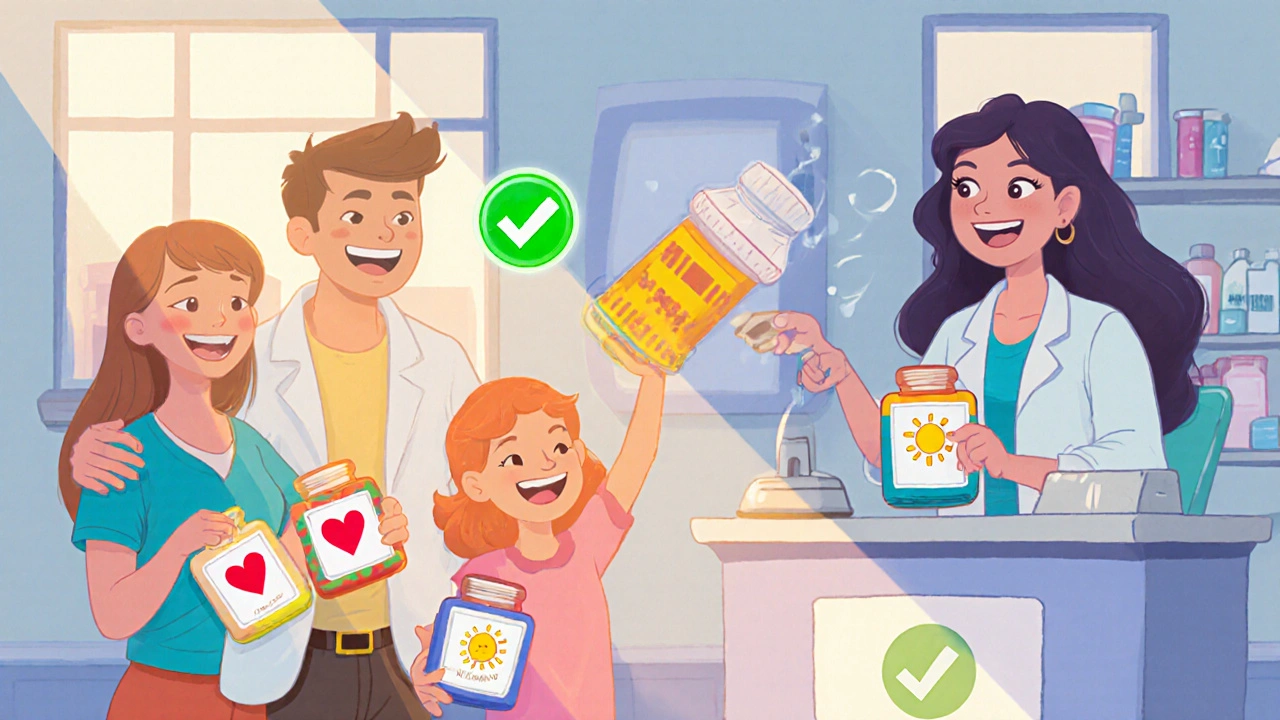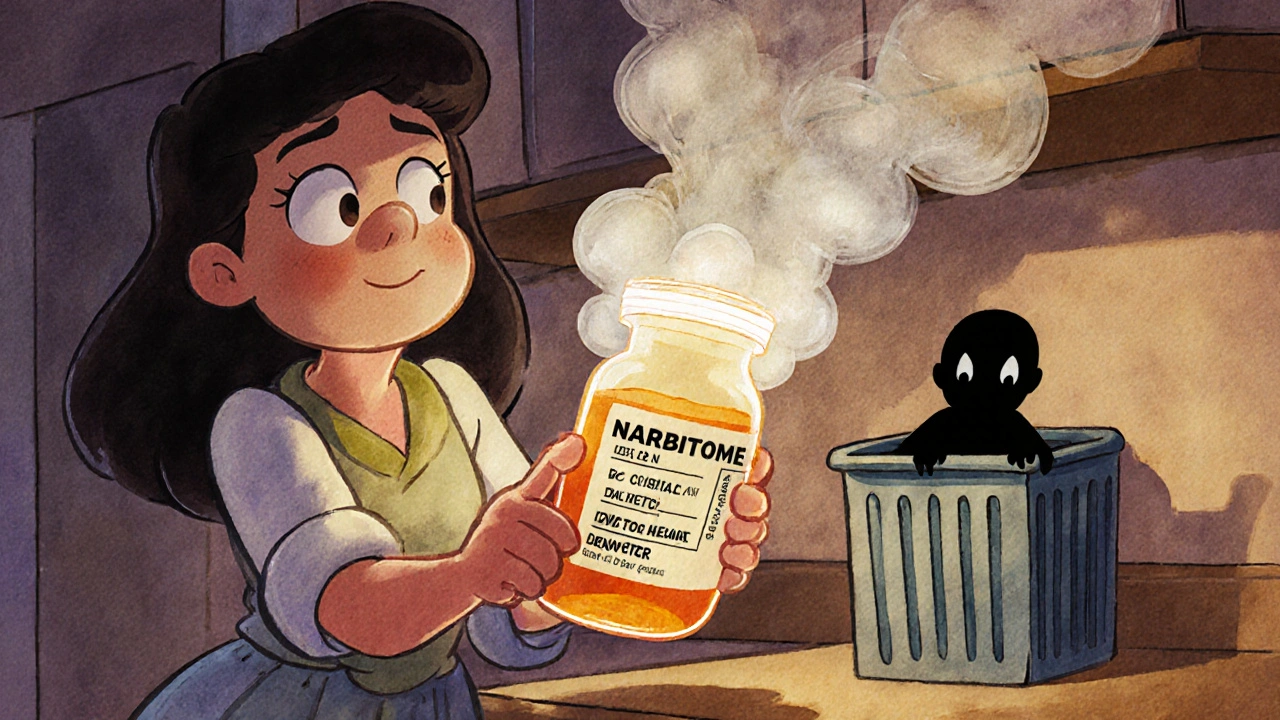Every year, over 400,000 people in the U.S. become victims of identity theft linked to discarded prescription bottles. Your name, birth date, doctor’s name, and even your medical condition are printed right on those little plastic containers-right where anyone can see them if you toss them in the trash. It’s not just a privacy issue. It’s a real risk for fraud, fake prescriptions, and insurance scams. And the worst part? Most people don’t even realize how dangerous it is to just throw the bottle away.
Why You Can’t Just Toss the Bottle
You finish your antibiotics. You empty your pain pills. You grab the bottle, rinse it out, and toss it in the recycling bin. Sounds harmless, right? But here’s what happens next: someone else finds it. Maybe a dumpster diver. Maybe a neighbor cleaning up. Maybe a thief who knows exactly what to look for. Prescription labels contain everything a fraudster needs: your full name, address, date of birth, the name of your doctor, the pharmacy, and often the condition you’re being treated for-like diabetes, depression, or chronic pain. With that info, criminals can impersonate you to get more drugs, file fake insurance claims, or even open credit accounts in your name. The FTC says prescription labels are one of the top five sources for medical identity theft. In 2021 alone, healthcare fraud cost victims over $560 million. It’s not just about theft. It’s about control. Someone with your prescription data can walk into a pharmacy and ask for refills under your name. Pharmacies don’t always check IDs thoroughly, especially if the name matches. That’s how people end up with opioid prescriptions they never asked for-or worse, someone else gets them.The Three Ways to Remove Personal Info (Ranked by Effectiveness)
There are three main ways to handle this. Only one of them is truly reliable. The other two have serious flaws.- Chemical Dissolution (Best Method) - Use a solvent like Titan Labs’ Cleanup Solvent-22. This is an acetone-based formula designed specifically to dissolve the waterproof adhesive on prescription labels without damaging the bottle. You spray it on, wait 15-20 seconds, then peel. The label comes off clean. No residue. No ghost text. No chance of recovery. This method works on 98.7% of bottles made from polypropylene or high-density polyethylene-the two most common materials. It takes less than 35 seconds per bottle. If you plan to reuse the bottle for vitamins, supplements, or travel containers, this is your only safe option.
- Permanent Marker Obscuration (Acceptable but Risky) - Cover every bit of text with a thick, black Sharpie. Do it three times, overlapping each layer. This is what many hospitals, including CHOC, recommend as a backup. But here’s the catch: 63% of the time, the ink doesn’t fully block the data. Under infrared light or with a smartphone photo enhancement app, the original text can still be read. A 2021 Javelin Strategy study found that 41% of "blacked-out" labels still revealed personal info. The FTC says this is acceptable if removal fails-but only if you’re certain you’ve covered everything. And even then, you’re taking a gamble.
- Physical Peeling (Worst Method) - Try to peel the label off by hand. It sounds simple. It almost never works. Modern prescription labels use acrylic adhesive that’s waterproof and designed to stick permanently. In tests, manual peeling left behind full data on 92% of bottles. Even with heat from a hairdryer or soaking in vinegar, success rates are below 65%. You’ll end up with sticky, half-removed labels that still contain your info. Don’t waste your time.
What to Do With the Bottle After Removal
Once the label is gone, you’ve got options. If you want to reuse the bottle-say, for organizing pills on a trip, storing small screws, or keeping craft supplies-clean it with warm soapy water and let it dry. The plastic is durable. Many people repurpose them as travel pill cases. Just make sure the label is completely gone. No residue. No smudges. Hold it up to the light. If you can still see even a single letter, go back and fix it. If you’re just getting rid of the bottle, don’t recycle it yet. First, destroy it. Shredding is the gold standard. But most home shredders can’t handle plastic bottles. That’s why services like LegalShred.com exist-they specialize in destroying medical waste. If you don’t have access to that, crush the bottle underfoot or cut it open with scissors. Then throw it away. Never put it in recycling with the label still attached. Recycling centers don’t remove labels. Someone else will find it.
What Pharmacies Are Doing About It
Big pharmacy chains like CVS and Walgreens started installing label-removal stations in 2020. These are small kiosks with built-in shredders and solvent dispensers. You drop off your empty bottles, press a button, and the machine removes the label and shreds the plastic. It’s free. It’s fast. And it’s becoming more common. Some hospitals, especially pediatric ones, now include label-removal instructions right on the prescription bag. CHOC, for example, gives patients a printed guide with step-by-step photos. And the DEA’s National Prescription Drug Take-Back Day now accepts unlabeled bottles-meaning they expect you to have removed the info yourself.Why Marker Doesn’t Cut It (And What Experts Really Think)
You’ve probably seen videos online where someone just scribbles over the label with a black marker. It looks easy. It looks safe. But experts don’t recommend it as a primary method. Melody Sun, a clinical pharmacist at CHOC, says it’s a last resort. "If you can’t remove the label, then mark it. But don’t assume it’s gone. Check it again." Her hospital’s own testing showed that 63% of marker-covered labels still leaked data under infrared scanning. That’s not a small risk. That’s a major vulnerability. Dr. Jen Caudle, a family physician with over 200,000 YouTube followers, demonstrates solvent-based removal in her videos because she’s seen the damage firsthand. Her viewers report saving their pill organizers from being thrown out-because they could reuse them safely. That’s the real win: keeping your bottles useful while keeping your data private. The FTC’s 2023 guidelines are clear: "Complete label removal is preferred." They don’t say "cover it up." They say "remove it." That’s the standard.
How to Do This in Under a Minute (Step-by-Step)
Here’s the simplest, most reliable method:- Put on gloves or use a paper towel. The solvent can be harsh on skin.
- Place the empty bottle on a flat surface in a well-ventilated area.
- Spray Cleanup Solvent-22 (or similar acetone-based label remover) directly onto the label. Cover it completely.
- Wait 15-20 seconds. You’ll see the label start to curl.
- Peel it off slowly from one corner. If it sticks, spray again.
- Wipe the bottle with a damp cloth to remove any leftover adhesive.
- Hold it up to the light. If you see any text, repeat the process.
- Dispose of the label in the trash. Recycle the clean bottle or reuse it.
What Happens If You Don’t Do This?
The cost of ignoring this step isn’t just theoretical. The average victim of medical identity theft loses $1,347. That’s not just money. It’s hours spent calling banks, filing police reports, and fighting credit bureaus. It’s stress. It’s anxiety. It’s the fear that someone is using your name to get drugs-or worse, that your medical history is being sold to marketers or hackers. And it’s preventable. Every single time.What’s Coming Next
The future of medication labels is changing. Companies like McKesson are testing RFID-enabled bottles that automatically erase personal data after 30 days. Pfizer ran trials with UV-erasable ink that fades under sunlight. But those are still in testing. Right now, the solution is simple: take control before you throw it away. Don’t wait for the system to fix itself. You’re the last line of defense. And you don’t need special tools, expensive services, or a pharmacy visit. Just a $15 solvent, a few seconds, and the knowledge that your privacy matters.Can I just throw away the pill bottle without removing the label?
No. Throwing away a pill bottle with the label intact puts your personal information at risk. Identity thieves routinely search through trash for prescription labels to steal names, addresses, and medical details. Even if you think no one will look, someone might-and they can use that info to commit fraud, get controlled substances, or file fake insurance claims. Always remove or destroy the label before disposal.
Is using a black marker enough to hide my info?
It’s better than nothing, but not reliable. Studies show that 63% of blacked-out labels still reveal personal data under infrared light or with smartphone photo apps. Criminals use free tools to enhance images and recover text. If you must use a marker, apply three thick, overlapping layers and check the bottle under bright light. But for real security, remove the label entirely with a solvent.
What’s the best product to remove prescription labels?
Titan Labs’ Cleanup Solvent-22 is the most tested and effective option. It’s an acetone-based formula designed specifically for prescription bottle labels. It dissolves the waterproof adhesive in 15-20 seconds and leaves no residue. It costs about $15 and is available on Amazon. Other solvents like nail polish remover (acetone) can work too, but they’re less controlled and may damage the plastic if used improperly.
Can I recycle the bottle after removing the label?
Yes, but only if the label is completely gone and the bottle is clean. Most recycling centers don’t remove labels, so if any residue or ink remains, your bottle could end up contaminating other recyclables. Rinse it well after removing the label, then check your local recycling rules. Some places accept clean plastic bottles; others don’t. If in doubt, crush the bottle and throw it in the trash.
Do pharmacies help with label removal?
Many major pharmacies like CVS and Walgreens now have free label-removal kiosks in-store. You drop off your empty bottles, and the machine removes the label and shreds the plastic. Some hospitals and community centers also offer disposal events. Check with your local pharmacy or search for "prescription drug take-back day" near you. It’s free, fast, and secure.
How soon after finishing my meds should I remove the label?
Do it within 24 hours. The longer you wait, the more likely you are to forget-or to accidentally throw the bottle away without removing the label. CHOC’s patient data shows that delaying label removal increases identity theft risk by 40%. Make it part of your routine: as soon as the bottle is empty, remove the label. It takes less than a minute.
Is this really a big problem?
Yes. In 2022, over 1.35 million healthcare-related identity theft cases were reported in the U.S., and prescription labels were involved in nearly 1 in 5 of them. The average victim loses over $1,300 and spends dozens of hours fixing the damage. This isn’t a minor privacy issue-it’s a widespread financial and medical threat. Taking five minutes to remove a label protects your identity, your money, and your health records.


Jenny Lee
November 17, 2025 AT 22:18Just threw away a bottle last week without thinking. Now I’m paranoid. Thanks for the wake-up call.
Evan Brady
November 19, 2025 AT 02:34Cleanup Solvent-22 is the real MVP. I’ve been using it for six months now-no more sticky residue, no ghost text. I even reuse the bottles for my supplements. Total game-changer. You don’t need to overthink it. Spray, wait, peel. Done.
Saket Sharma
November 19, 2025 AT 10:53Marker method is a systemic failure. 63% data leakage? That’s not mitigation-it’s theater. You’re not securing data; you’re performing security.
Shravan Jain
November 20, 2025 AT 20:18Acetone-based solvents are not FDA-regulated for consumer use. You’re introducing volatile organic compounds into your home environment under the guise of ‘privacy.’ Is this really worth the neurotoxic risk?
Brandon Lowi
November 22, 2025 AT 17:07So we’re supposed to trust a $15 Amazon product made in China to protect our medical identity? Meanwhile, the DEA’s taking bribes from Big Pharma to keep these labels intact. This isn’t about privacy-it’s about control. And they want you distracted while they sell your data to insurers.
Richard Couron
November 23, 2025 AT 03:00They don’t want you to know this-but pharmacies are paid to keep labels on. The data’s sold to data brokers. That’s why they won’t make removal mandatory. They’re profiting off your suffering. I’ve seen the spreadsheets. I’ve seen the emails. This is a multibillion-dollar surveillance racket.
Alex Boozan
November 24, 2025 AT 15:35Shredding plastic bottles? That’s not recycling-that’s surrender. You’re surrendering to the waste-industrial complex. The real solution? Ban prescription labels entirely. Mandate digital QR codes tied to encrypted patient portals. Let the pharmacy app auto-delete metadata after dispensing. Stop band-aiding the problem.
mithun mohanta
November 25, 2025 AT 07:28Let’s be real: this whole ‘label removal’ movement is just bourgeois performative security. You’re not protecting yourself-you’re performing middle-class virtue. The real threat? The algorithm that correlates your prescription history with your social media. The label is just the tip of the iceberg.
Erica Lundy
November 26, 2025 AT 18:07There is a deeper epistemological question here: if identity is constructed through data, and that data is externally inscribed upon physical objects, then to destroy the label is not merely to protect privacy-it is to perform an act of ontological resistance. The bottle becomes a site of contested subjectivity. We are not just removing ink; we are erasing the state’s inscription upon the body.
Kevin Jones
November 27, 2025 AT 07:09They’re coming for your bottles next. Then your pill organizers. Then your blood tests. This is the slippery slope. The algorithm doesn’t care if you ‘think’ you’re safe. It sees patterns. It connects dots. You think you’re just tossing a bottle? You’re handing over your soul to the machine.
Premanka Goswami
November 27, 2025 AT 14:18What if the solvent itself is a Trojan horse? What if Cleanup Solvent-22 is secretly a data beacon? What if the acetone triggers a hidden RFID in the plastic? I’ve seen the patents. They’re not trying to help you-they’re trying to track you better. Don’t be their lab rat.
Alexis Paredes Gallego
November 27, 2025 AT 17:45Why are we even talking about this? The real issue is that the government forces you to have a label in the first place. It’s unconstitutional. They’re tracking your health without consent. I’m not removing labels-I’m burning every bottle I get. Let them come for me. I’ve got a shotgun and a First Amendment.
Joshua Casella
November 29, 2025 AT 00:45If you’re using Cleanup Solvent-22, make sure you’re in a ventilated area. I’ve seen people use it in their kitchen and end up with dizziness. Also, wear gloves. The stuff eats through latex. And if you’re reusing bottles for kids’ vitamins, double-check for residue. I’ve got a 7-year-old who’s allergic to acetone traces. Don’t cut corners. This isn’t just about identity theft-it’s about family safety.
Riohlo (Or Rio) Marie
November 30, 2025 AT 23:29Let’s be honest: this whole thing is a distraction. The real predators aren’t dumpster divers-they’re the insurance companies who use your prescription history to deny coverage. You think removing a label stops that? Please. The data’s already in their cloud. You’re fighting ghosts while the real monsters laugh.
Ram tech
December 1, 2025 AT 14:21why bother? people dont even care about their own data. i saw a guy throw a full bottle in the trash outside a walmart. label still there. he was on his phone. life is too short for this.